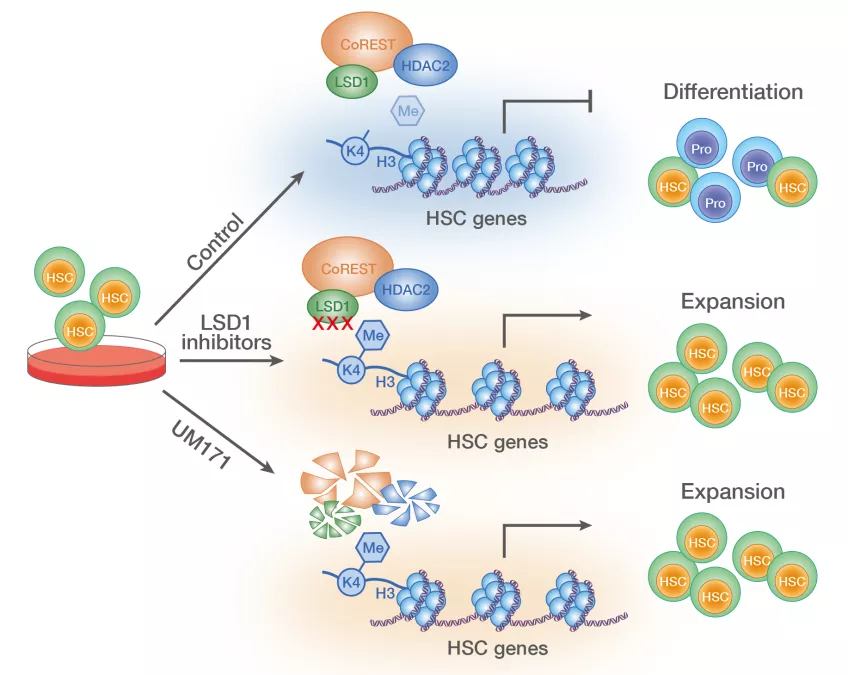Hematopoietic stem cell transplantation is a curative therapy for many patients suffering from life threatening blood disorders. This treatment is currently limited by the availability of compatible bone marrow donors and, as a result, transplant of unrelated donor umbilical cord blood is an attractive alternative.
This approach has the advantages of rapid availability and reduced stringency for a complete donor/recipient match, but is limited by a relatively low number of stem cells within a single cord blood unit. One focus of the Stem Cell Regulators research group, led by Prof. Jonas Larsson, is the development of new strategies to expand stem cells ex vivo, allowing for the treatment of patients who otherwise would lack a suitable donor.
“When grown outside the body hematopoietic stem cells proliferate and differentiate from an immature state to more mature blood cell types.” explains Prof. Larsson. “We aim to identify novel ways to counteract this maturation, pushing stem cells to self-renew and increase in numbers.”
In a study published in the journal Blood, the Larsson group targeted the enzyme LSD1, part of the CoREST complex, known to mediate the epigenetic modification of DNA and pushing the differentiation of stem cells into mature blood cells.
“We hypothesised that by reducing LSD1 levels using small molecule drugs we could halt stem cell differentiation and stimulate expansion.” explains postdoctoral researcher Agatheeswaran Subramaniam and first author on the paper.
“This turned out to be the case for both cord blood derived and adult bone marrow stem cells, with LSD1 inhibition expanding stem and progenitor cells from different sources and different stages of development.”
To gain insights into how targeting LSD1 led to the expansion of stem cells, the group performed gene expression profiling. They compared LSD1 inhibition to treatment with UM171, a human hematopoietic stem cell promoting molecule identified in 2014 and currently in phase II clinical trials, despite an as yet unidentified mechanism of action. The gene signatures of LSD1 inhibition and UM171 treatment were strikingly similar.
The research group then postulated that these treatments could be working by the same mechanism.
Through a collaboration with Prof. Roman Zubarev at Karolinska Institute, the key targets of UM171 were established using a technique known as Thermal Proteome Profiling. This approach, which identifies interactions between small molecules and proteins, confirmed the direct binding of UM171 to LSD1, as well as to the core structural component of the CoREST complex, RCOR1.
Extensive analyses by Kristijonas Žemaitis, a PhD student in the Larsson lab, revealed that UM171 directs the components of the CoREST complex to degradation via the ubiquitin proteasome pathway, the system used by the cell to break down proteins.
“In this study have we identified a novel target for human hematopoietic stem cell expansion ex vivo, as well as taking steps to understanding the previously undetermined mechanism of action of UM171.” reflects Agatheeswaran. “The most striking finding was the extremely rapid and efficient degradation of members of the CoREST complex by UM171.”
What remains unclear is exactly how the CoREST complex is targeted and its degradation triggered. An understanding of this has the potential to reveal principles that can be exploited for purposes not only limited to stem cell expansion.
For more information about the study, please contact:
Prof. Jonas Larsson
Stem Cell Regulators group
Division of Molecular Medicine and Gene Therapy
Department of Laboratory Medicine
Lund University
Sweden
Jonas [dot] Larsson [at] med [dot] lu [dot] se (Jonas[dot]Larsson[at]med[dot]lu[dot]se)



